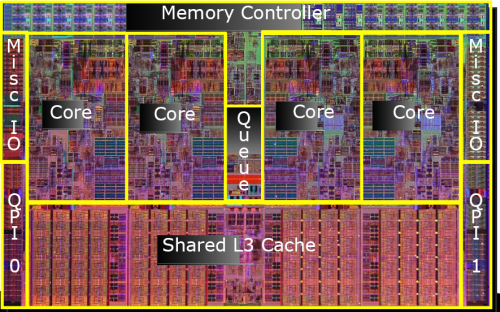Monolithic monster
The monolithic design of Nehalem
Nehalem - or Intel Core i7 as it's known in its desktop guise - can be understood by looking at the following high-level block-diagram. We'll be discussing its features in relation to Penryn and AMD's also-quad-core Phenom X4 processors.
Core i7 is a monolithic quad-core design, meaning that the entire silicon required for the core is cut from one portion of the wafer. This is the same principle used by AMD but in direct contrast to Intel's own Core 2 (Penryn), of course, where two such dies are effectively 'glued' together to produce a multi-chip-module quad core processor.
The change from MCM to monolithic matters because it means the new design doesn't suffer from the per-core memory-bandwidth contention that plagues incumbent Core 2 quad-core CPUs, where the two dies share information with each other over the already-constricted front-side bus. Here, like AMD, access is unfettered in this respect.
Weighing in at 731m transistors and a die-size of 263mm, Core i7 isn't that much larger than Penryn's 214mm overall die. Transistor count, however, is down from 820m. We'll get to the apparent discrepancy between die-size and transistor-count in due course.
Before we do, let's roll out some of the Core i7's key features, going from the outside in.










